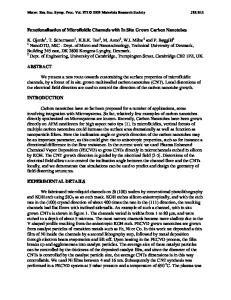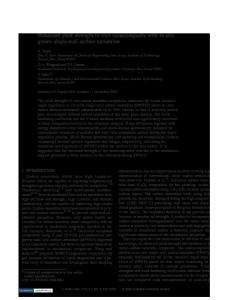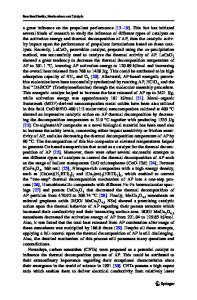Carbon nanotubes grown in situ by a novel catalytic method
- PDF / 320,071 Bytes
- 3 Pages / 612 x 792 pts (letter) Page_size
- 33 Downloads / 413 Views
MATERIALS RESEARCH
Welcome
Comments
Help
Carbon nanotubes grown in situ by a novel catalytic method A. Peigney, Ch. Laurent, F. Dobigeon, and A. Rousset Laboratoire de Chimie des Mat´eriaux Inorganiques, ESA CNRS 5070, Universit´e Paul-Sabatier, 31062 Toulouse Cedex, France (Received 23 August 1996; accepted 4 November 1996)
Carbon nanotubes can be produced by the catalytic decomposition of hydrocarbons on small metal particles. However, nanotubes are generally produced together with non-tubular filaments and tubes coated by pyrolytic carbon. We propose a novel catalyst method for the in situ production, in a composite powder, of a huge amount of single- and multiwalled carbon nanotubes, having a diameter between 1.5 and 15 nm and arranged in bundles up to 100 mm long. We anticipate that dense materials prepared from such composite powders could have interesting mechanical and physical properties.
Carbon nanotubes,1 which may possess outstanding properties, are currently prepared by arc-discharge. Despite continuous improvements,2–7 this method has a poor selectivity between the different forms of carbon obtained and requires a purification step limiting nanotube yield to about 1%.7 The method of catalytic growth on nanometric metal particles8–11 leads to carbon fibers among which nanotubes may be found together with nontubular filaments and tubes coated by pyrolytic carbon. The minimal tube diameter that can be so achieved is that of the catalytic particle. Several authors12–17 tried to adjust parameters such as the catalyst composition and the reaction atmosphere to maximize the nanotube yield and to minimize the tube diameter. Ivanov et al.16 have reported very small amounts of thin tubes (4 nm), and tubes up to 60 mm long, but they point out that the longest tubes are also the thickest. We propose a novel catalyst method for the in situ production, in a composite powder, of a huge amount of single- and multiwalled carbon nanotubes, having a diameter between 1.5 and 15 nm and arranged in bundles up to 100 mm long. In earlier works,18–21 we have shown that metaloxide nanocomposite powders are advantageously prepared by selective reduction in hydrogen of oxide solid solutions. Such powders consist of oxide grains containing a dispersion of metal particles smaller than 10 nm in diameter. Most particles are found inside the oxide matrix grains, but some are located on the surface. It was thought that provided we use a hydrogenhydrocarbon gas mixture, the in situ reduction of the very homogeneously dispersed surface ferric ions would allow the pristine iron particles obtained to be active at a size adequate for the catalytic growth of nanotubes. We have prepared the stable a form (corundum) of an Al1.9 Fe0.1 O3 solid solution by the method described elsewhere19 and reduced it at 1050 ±C for 1 h in a H2 –CH4 gas mixture (18 mol % CH4 ). The resulting powder was slightly metallized and observed by scanJ. Mater. Res., Vol. 12, No. 3, Mar 1997
http://journals.cambridge.org
Downloaded: 19 Nov 2014
ning electron m
Data Loading...











